#Caribert archon quest
Explore tagged Tumblr posts
Text
when I played Caribert, I was pretty disappointed about the lack of impact Dain seemed to have on Kaeya, honestly. during Kaeya's hangout, he didn't mention the weird cryptic blond dude who just dropped family lore once, which I thought would have been pretty important?
but in truth, I think Dain actually had a HUGE impact on Kaeya.
we can all know that from Kaeya's personal lore and former events that Kaeya had very conflicted feelings over his duty to Khaenri'ah and his love for Mondstadt, even with his estranged relationship with Diluc (which now seems partly fixed?), but in the performance route of Kaeya's hangout, Kaeya makes his choice.
The story of Prince Qubad is a very, very thinly veiled metaphor for Khaenri'ah all throughout, and then we finally get to the end scene of the play:
Kaeya: When I departed my beloved home to fight in a foreign land, I did so to honor his (my father's) wishes and for my duty to our people. Kaeya: alas, is this fate's grand design… that I should spend the rest of my days in a foreign land, till I am laid to rest in a grave far from home? K: Must it be so…? K: my dear audience, I ask you this: do you believe in fate? if fate decreed that your life was to end in tragedy, what would you do? Traveler: I would challenge my fate, and rise above it. / I would bravely face my fate. K: then so must it be! I shall discard this intaglio, and rid myself of the shackles of fate. G: my dear prince, do you intend to betray your father, and abandon your heritage? K: fate means to send the machinations of war to every corner of the land, to fan the flames of conflict til they engulf the entire world…
K: fate would see my sword tainted with the blood of innocents, that the bright banner of my homeland might fly in every nation known to mankind. K: but I shall not bow to the will of fate. I am no pawn in heaven's plan. K: I, Kaeya Qubad, will spend the rest of my days in a foreign land, til I breathe my last in a place far from home. K: but I must walk this path, or freedom dies by my hand. goodbye, my tribe and kin. farewell, sweet land of my birth.
after a lifetime of questioning his role, Kaeya makes his choice for Mondstadt. and I think this happening after meeting Dain isn't a coincidence. (and no, not in a soulmate way or shipping way- this is Kaeya's moment of choice, not infatuation.)
after not only learning the history of his origins, Kaeya meets a Khaenri'ahn who... doesn't want to return Khaenri'ah to its glory days? who is more focused on helping others and minimizing damage than causing more for his own gain? who chose his path and has not budged since, even through loss?
Kaeya gets to see someone who is so Khaenri'ahn, so human at his core, someone who cares not for the fate and tragedy of their nation. Kaeya gets to meet someone from his homeland who tells him to leave it all behind, who tells him he should take the chance he has been given at his own life; who actively discourages the idea of Kaeya being a fated "prince" or being indebted to Khaenri'ah.
even though he never said it, I think meeting Dainsleif helped Kaeya choose his own path, which is all Dain ever truly asked of him, anyway.
good for Kaeya.
(i understand that i used "ship" tags but those are more for visibility and duo name than anything else. idm if you ship them, i just request that your tags do not turn my analysis post into a ship post, pls! :)
#kaeya#kaeya alberich#kaeya ragnvindr#genshin kaeya#genshin impact#dainsleif#genshin dainsleif#genshin lore#genshin analysis#dainkae#kaedain#i guess#that tag is mostly for visibility#caribert#caribert archon quest
617 notes
·
View notes
Note
helloo i just stumbled acress your blog and if you dont mind id like to ask-
FELLOW GENSHIN LORE FAN????
if yes then what are your thoughts on the next dain archon quest-
feel free to ignore/not answer btw, no pressure ^^
FUKC YEAH LOORREEE
I’m more into Khaenri’ah/Abyss lore, than anything else tho, if i’mma be honest lol.
I’m absolutely interested in lore and stories and general though to be honest I think my attention span and sleep deprivation doesn’t allow me to make up anything to big from scratch
Σ(-᷅_-᷄๑)
But I’d love to bounce of others if it weren’t for my social anxiety so please I’d be absolutely interested in anything with this
I’m really late to answering this shit to where people have already posted the cutscenes of Caribert onto yt, which I watched because impulse control is a myth and I’m quest locked so-
If you haven’t seen it yet then by all means ignore the rest of my rambling;
So Kaeya is specifically the descendant of the founder of the Abyss Order, Chlothar Alberich. Kae outwardly says he has no idea of the origin, with how openly he handles his last name, but he also says it ties up some questions he’s had.
Of course, quote Diluc, “you can only trust half of what he says at best,” so of course taking that with a grain of salt:
At ‘worst’ that means Kae always fuckin knew/This is just the final confirmation about it, and he knows a lot more about the Abyss Order. (Also funfact: one of his first, base lines, like the ones you have access to w/ friendship lvl 1, have something asking “Is the Abyss Order bothering you?” Not to mention there’s an anecdote on “You’re scars of the dark? That’s… interesting.” Oh, and that first archon quest in the domains and stuff; Where Kaeya recognizes hilichurl aren’t this smart and looks like he’s about to talk with a Abyss Mage before adult barges in. And the. “Let’s just say I was blessed with certain… linguistic powers.” Shit, foreshadowing goes deep.)
At best: He had just a bit of knowledge about it, and confirmation opens a lot up for him.
I do doubt he’d actually turn to the Abyss Order, cause Hoyo making him essentially a villain/major (enough) antag would be… uh, unlikely to say the least. I can see some spying on the Abyss Order and double crossing them though, that fits with Kae.
And at the same time, Caribert is apparently Chlothar’s son, right? He’s obviously affected by the curse, being the hilichurl. And so if we’re going with the “Kaeya is from straight up alive Khaenri’ah, not just the ruins” that either means through shenanigans Caribert turned into Kae or Kae has a sibling.
However, Kaeya is called a descendant of Chlothar, so that’s a separation of time; But then that also brings up the question of how Kaeya knows of Khaenri’ah? His Story says things/describes Khaenri’ah in things in general that paints it as if he actually lived there.
Did he live in ruins? Then I doubt he’d have as much knowledge about Khaenri’ah as he could very well likely have (and not tell us, obviously, the little liar [affectionate]). Not to mention the paper he stole when his father showed him about “what being an Alberich” is about and stuff; embers blah blah; that doesn’t sound like ruins…? Ugh. He has a stupid amount of 4-pointed stars on his design too; There is no way he doesn’t know at least a good amount about Khaenri’ah.
Following the Caribert -> Kaeya thing;
Chlothar did fuck around with the Abyss sibling (I play Aether so I’m gonna say Lumine) to try and find a way to help Caribert with the curse and stuff. Hell, after we dig up the bodies when Dain wakes us up, Dain questions if Chlothar found a way to stop the curse or something. So perhaps Chlothar did “cure” (to some level, otherwise they wouldn’t need to do the Loom of Fate shit) of some sorts that returned Caribert?
And then due to Abyssal time shenanigans (it’s already proven to fuck with time, look at Ajax/Childe) memories got fucked and Chlothar decided it’d be best to leave Kaeya in Mond, whether as a spy or for a better life? Kaeya does still have that eyes patch, after all. And it’s not implausible that there was a name change for ambiguity.
But at the same time, a ‘cure’ for the curse would be questionable - why hasn’t it been mass produced/practiced by now then? - not to mention I don’t think Kaeya would only get away from all that with just an eyepatch covering his face. And again, Kaeya was described as a “descendant” of Chlothar, and it’s referred to as an “ancestor/ancestry” specifically, so for the time thing it’s unlikely.
Not to mention, Chlothar also has a bigger star, closer to Dain than Kaeya’s. As Kae put it “pure-blood Khaenri’ahn”.
So yeah, Kaeya is probably just more of a descendant, if his appearance contradicting the description of a Khaenri’ahn has to say anything (“Light hair, fair skin, star-pupil” Kae is one of the 3 playable characters that has a darker skin tone, he has dark blue hair, and his star pupil is small than compared to Dain or Halfdan. …Though Chlothar has black hair. Huh).
But bring up the fact that he describes Khaenri’ah like he’s lived there and the. That brings up and entire other question/argument. Then what was Kaeya’s father, Chlothar or not, doing? Was he part of the Abyss Order? Or was it just something purely Khaenri’ahn? How is he not affected by the curse; was it the fact that he’s only part Khaenri’ahn?
So much questions so little information. This is the reason I love and hate lore aaaaaaa-
Okokok
Caribert & Kae are siblings? - Again the “descendant” and “ancestry” thing, and he is suspiciously absent if they are siblings. (Huh, the abyss/Khaenri’ah is having the small theme of siblings/siblings in arms. Aether & Lumine; Dain & Halfdan as brothers in arms; hell, in the more abyss based - Childe, you know with Teucer and shit, and then Kaeya, with Caribert or Diluc.
Of course I’m in love with the head cannon that Kae is from when Khaenri’ah was actually alive lmao :,)
And that’s only Kaeya, granted he is my favorite.
Now, the travelers. (Again, Aether as traveler, Lumi as Abyssal sibling)
Right. So we see Lumine’s memories of her time traveling with Dain, in which she meets Chlothar Alberich, who she sorta-helps with his son, Caribert. Then, once she wakes up, Chlothar goes on for a bit about the abyss being the answer to the curse or something, etc.
Assumedly, this would be where Chlothar founded the Abyss Order? At least, this is the main inviting event that leads to the Abyss Order.
I think, if I’ve read this correctly, Lumine is still traveling with Dain, so it’s not like she actively helps and joins with Chlothar. If what we say as the traveler in Lumine’s memories actually did happen, she probably joins the Abyss later; Alberich, maybe partly the fact that she’s princess of Khaenri’ah and was also incredibly helpful to the creation of the abyss order, gives her the title of Princess in the Abyss Order.
Did something happen during the travel that caused her to join the Order? Or was it just the fact of mulling it over for fuck knows how long and then splitting with Dain that got her to join?
Also, if the Alberich clan took over after the fall of King Irmin, then how do Lumine and Aether go into this? Are the the kids of King Irmin? We’re they too young to rule or something; then how was Lumine old enough to see the fall of Khaenri’ah? By then wouldn’t there be enough time for at least one for the sibling to rule? Then how come there’s no mention of it?
Hell there’s even the question of just how Aether could share memories with Lumine. Technically, nothing happened there that would indicate that there’s be like.. something to fuck around with for memories. By all means it’s just a place. Did another event happen here? Was the curse from Caribert just that strong/not as specific? Am I just looking a bit too into this part because let’s be honest they probably just need to drop this lore somehow?
Also, when Chlothar is talking to Caribert on the ledge, he says something along the lines of “remember this is a new place”
Essentially: This is new from what we know, it weird. (Come back here, please)
That either means something was fucky with Sumeru making it fantastical or they just left Khaenri’ah, which is more likely.
Then how long has Dain & Lumine been travling? The ruins of Khaenri’ah are said to be underground around Sumeru, curtesy of Kaeya*.
(*Wait, for the small story Kaeya tells, he say he want to go to Sumeru to learn more of his origins - again, grain of salt for the pathological liar - but that overall implies that he’s never been to the ruins of Khaenri’ah. Of course he could just be lying and as a child he just want to go home, even if said home we’re ruins, but still.)
How recent was the destruction of Khaenri’ah, then? Cause Dain & Lumine are both treating it as if it’s been long - Chlothar says something like “your alias” which implies that Lumine has been using the name “Traveler” during her travels with Dain long enough for it to just become.. well, her deficit alias.
And if Lumine was the Princess of Khaenri’ah, why would she give Chlothar an alias? He clearly has big fuckin stars for his pupils; If the destruction of Khaenri’ah was that recent, why would she be so guarded? Was Alberich suspicious during the reign of Khaenri’ah? But the Alberich clan took over in Irmin’s stead, meaning they were trustworthy and powerful enough to keep an entire kingdom together.
Just how long as is then since Khaenri’ah’s destruction, then? If it’s been long enough to where being weary of another Khaenri’ah is just “expected”, then there’s no reason for Chlothar to remind Caribert about our go Khaenri’ah.
If it hasn’t been to long, then why has Lumine not revealed herself, relieved at the survival and… not-hilichurl-indication of her people? And why do Dain & Lumine treat/talk about their travel, even just in Sumeru, as if it had went on for an long time?
Aaaaaaa-
I’d continue but’s it’s 2 am on a school night (morning) and I have an “out-of-sight, out-of-mind” brain so just. Take this. GN and thanks for asking! :D
#this has been mainly Kaeya huh#ah well#I also want more lore on Skirk and abyss!Childe#but I mean self indulgence lol#genshin impact#kaeya alberich#kaeya#lumine#Aether#traveler genshin impact#lore#Caribert archon quest#Caribert#Chlothar Alberich#lore speculation#theories#Genshin spoilers#spoilers#whoop whoop#goodnight#<3#lmao#not beta read#we die like the light in Childe’s eyes
32 notes
·
View notes
Text
Doomed ship save me.... save me doomed straight ships

507 notes
·
View notes
Text




still, i don't wish you to forget me
#do you guys think atossa wait for caribert till her last breathe🧎🏻♀️#⚠️ 4.7 archon quest spoiler#genshin 4.7#4.7 spoilers#CRYING SCREAMING THROWING UP#rkgk#sketch#doodle#caribert#atossa#caribert alberich#genshin impact#原神#fanart#genshin fanart#bedtime story#an everlasting dream intertwined#aether#lumine#dainsleif#genshin angst#genshin npc
355 notes
·
View notes
Text

“Farewell, Atossa.
I apologize for making you know me unwillingly.
Still, I don’t wish you to forget me.”
It’s ok I didn’t need my heart today 😭
#genshin#Genshin impact#Genshin impact story#genshin impact spoilers#Genshin impact archon quest#caribert#teyvat#littleprincessposts
158 notes
·
View notes
Text

✧ I recognise your eyes…
#dainsleif my babygirl#genshin impact#artists on tumblr#genshin#illustration#dainsleif#kaeya x dainsleif#genshin impact dainsleif#archon quest 3.5#caribert#kaeya fanart#kaeya#kaeya alberich#genshin impact kaeya#abyss order#khaenri'ah#dainkae
1K notes
·
View notes
Text
AU WHERE NAHIDA (IN MY TEAM AND PRESENT FOR THIS SHIT) RIPS CARIBERT OUT OF HIS FUCKING LOOM PRISON WITH HER MEMORY POWERS AND LETS HIM LIVE A FULL HUMAN LIFE IN VIMARA VILLAGE AND GETS HIS CUTE FIRST LOVE ROMANCE WITH ATOSSA....
#honest blurbs#*screaming crying throwing up*#ugh all the lil character details about him and hes in HALF an archon quest#hes like a introverted kaeya#HE REALLY PLAYED DAIN LIKE A FIDDLE JUST FOR THE HILICHURLS TO GET A MOMENT OF PEACE LIKE...#kaeya alberich#caribert#papa pierro is looking more and more likely tbh
126 notes
·
View notes
Text
Caribert is such a pure soul, after everything what happened to him, he still want to comfort the people from khaenriah and the feeling of being wanted and existed, you deserved it Caribert, even a little time spending with the people in Virmara Village.



Dain is dropping the lore again and left, however now we know who are the sinners of Khaenriah, and I wonder what are their plans for the world of teyvat? Does Alice know? After all Rhinedottir is part of hexenzerkel. 🧐





I really wish we are able to hug our sibling, these two are so precious. 🥹☺️🥹

#genshin impact#traveler#paimon#lumine#aether#dainsleif#caribert#atossa#amidhiah#bedtime stories#archon quest bedtime stories#barham#abyss twin#loom of fate
56 notes
·
View notes
Text
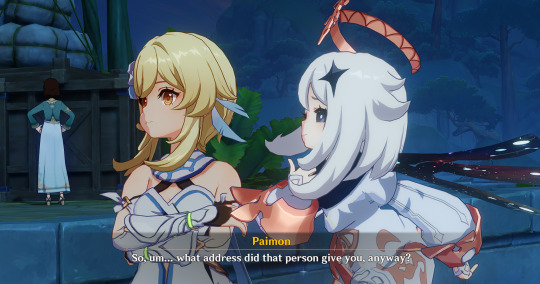

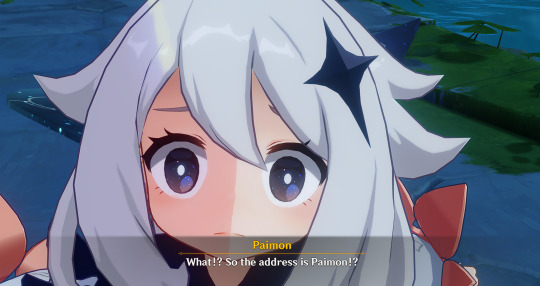
While this is super funny (Postage Paimon) there is something sweet about her being our address.
Like she is our home, no matter were we go...
#or because she is so loud it's hard not to notice her lmao#genshin impact#genshin spoilers#paimon#lumine#genshin archon quest#caribert
659 notes
·
View notes
Text
Genshin Impact | Images from Bedtime Story (1/2)
Placed under the cut for spoilers.
Download Link (Google Drive)








#genshin impact#assets#cutscenes#event artworks#character artworks#in quest#archon quest#bedtime story#caribert#jehiet#amadhiah#bahram#atossa#aether#dainsleif#paimon#lumine
39 notes
·
View notes
Text
[3.8] Technology as a False God: On "Evolution," the Duality of Machines, Replication, and Wisdom
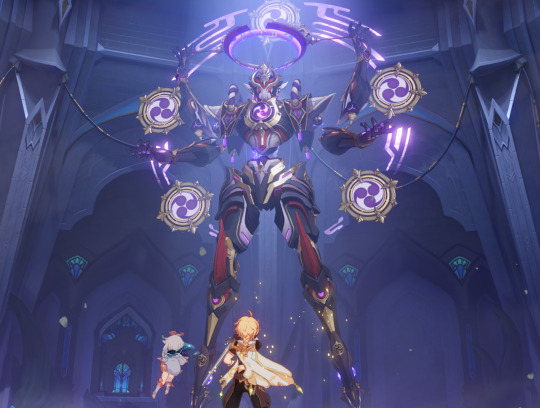
“To recognize untruth as a condition of life: that is certainly to impugn the traditional ideas of value in a dangerous manner, and a philosophy which ventures to do so, has thereby alone placed itself beyond good and evil.” –Friedrich Nietzsche, Beyond Good and Evil
Before we move on to the nation of justice, I want to do one last inquiry into the narrative significance of machines and technology in Genshin’s 3.x patch cycle. Here, I’ll discuss how divinity (or “godhood”) and technology are treated as interchangeable tools to surpass fate and the boundaries of mortality, the potential problems with treating them this way, and propose an alternative relationship between humanity and technology as illustrated through Karkata, Benben, Tamimi, and Mehrak. By foregrounding machines, we learn something intriguing about ourselves and the “truth” of this world as we perceive it.
SPOILERS: All Sumeru Archon Quests, Caribert, the Golden Slumber and one out-of-context screenshot from Dual Evidence, the Dirge of Bilqis and its post-quests, Khvarena of Good and Evil, Nahida’s second Story Quest, Faruzan’s hangout, an out-of-context screenshot from Baizhu’s Story Quest, and major spoilers for Persona 5 strikers at the end. Also some dialogue from Shadows Amidst Snowstorms and A Parade of Providence, two limited-time events from 2.3 and 3.6 respectively.
Disclaimer: I have tried my best to write this post so that it stands on its own, but because it is still a sequel it will probably make the most sense with the context of part 1. Here are the previous posts leading up to this one:
Part 0: On Dreams, the Abyss, Forbidden Knowledge, and Wish Fulfillment
Part 1: The Uncanny, Fate and the Machine
Terminology: Machine is sometimes used interchangeably with “technology” in this post.
Technology or tool here is referring to technologies specifically used to pursue a wish like immortality in the face of existential dread, not the use of technology or medicine (which I do not address here, and is very difficult to separate from the former) to facilitate someone’s life who could otherwise not survive without that technology, or would have a more painful lived experience without it.
Also, though I don’t engage directly with “A Cyborg Manifesto” here, Donna Haraway’s ideas have greatly influenced my own over the years since I read her in college (although I mostly disagree with her on many points, or at least don’t go as far in boundary deconstruction as she does). I owe my interest in technology studies to her and that piece. Her essay is linked here and at the bottom if you would like to read it.
(and finally with many, many, many thanks to my boyfriend for multiple beta reads despite not having played a single Hoyoverse game, helping me work out the philosophy bits and contextualizing them in history, and encouraging me to finish this)
TL;DR: Machines are friends, not food!
No Matter the Cost
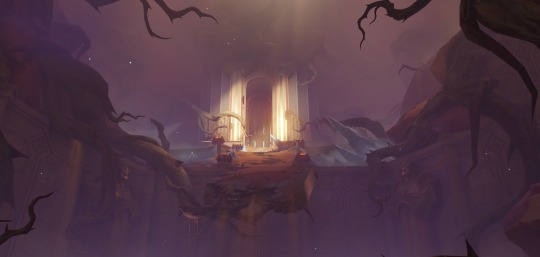
“...Perhaps it is as the notebook says, and we can find a power that transcends even that of the Abyss — the power of ‘evolution’...” -Records of Unknown Attribution (I) “Life, death... and the world around us all follow a set of laws... Hehe, but if you never test the limits, how can anyone know where the boundaries of these laws are?” -Baizhu Voicelines, Chat: Natural Laws “...Even the ominous thing that came down from the heavens shall be ours to use…” -Hyglacg, Shadowy Husk in the Chasm
Without a doubt, the star of this patch cycle is Khaenri’ah, which lurked in subtext and allegory in the Archon Quest, haunted Sumeru’s landscape with its massive defunct Ruin Golems, and finally smacked us in the face with its physical location in Khvarena of Good and Evil..
We already know that Khaenri’ah was a nation that put its faith not in the gods but rather in human ingenuity and technology, and that they ultimately attained a power so great that they “almost touched the dome of the firmament.” They did this by researching increasingly dangerous energy sources for their numerous mechanical creations, the Ruin Machines we are all too familiar with by now. They started out with Azosite, a Ley Line-based elemental energy source that powered their earliest Ruin Guard models, like those scattered around Devantaka Mountain.

Nasejuna: This giant furnace is used to make a substance known as Azosite. It is the core of this entire factory, and the Energy Blocks we saw earlier were derived from this place.
But this energy source proved inefficient and therefore inadequate for Khaenri’ah’s goals, which led them to seek a higher power from beyond the skies that could fuel their larger machines with perpetual energy. This likely is the bridge between Khaenri’ah’s fate and Chlothar’s mysterious remarks in Caribert about the Abyss Sibling:
Chlothar: We once believed that you would bring new strength and hope to Khaenri'ah. Chlothar: To us, you were the Abyss... A wondrous mystery far beyond our imagination and comprehension... Chlothar: ...And the one who controls the Abyss can control everything! Chlothar: We yearned for that future. We looked to you to take us there. Chlothar: But what did you bring us instead?
Though Khaenri’ah presents itself proudly as a godless nation, it may have been founded around the time when the celestial nails dropped in Teyvat’s first forbidden knowledge pollution event, which destroyed the unified human civilization. As potential survivors of this devastating act by the Primordial One, Khaenri’ahns then settled in a lifeless land without plants or animals of its own, and they hoped to build something there that belonged solely to humanity. The Heavenly Principles had turned on the world’s earliest humans, and they were powerless against them. Chlothar’s words betray the scars of this trauma on Khaenri’ah, as well as their desperation to control their fate by looking to the Abyss.
As a brief refresher from the previous part, we discussed how the German word heimlich denotes “the home,” all that is familiar and known, while unheimlich (uncanny) refers to all that is unfamiliar and external to the home, such as the wilderness. The Abyss sibling and the Traveler are external variables to Teyvat, making them otherworldly, unfamiliar entities full of potential to surpass Teyvat’s natural laws. Although the Abyss sibling is not a god per se, they were probably as close to a god as Khaenri’ah ever had, because to them the sibling embodied the higher power they were searching for, and they saw that “godliness,” a sort of functional divinity, was yet another technology for them to master. In this way, the Abyss sibling (and their functional divinity) was a powerful tool for Khaenri’ah’s desired end, the “future they yearned for,” a being who could deliver them to the end of their suffering under the Heavenly Principles.
It’s similar to what King Deshret represented to Rahman and the radicals in Archon Quest. The hopelessness of Sumeru’s situation before the Archon Quest’s conclusion is an allegory for the position humanity finds itself in under the rule of the Heavenly Principles, with the Akademiya symbolizing Celestia and the desert dwellers symbolizing Khaenri’ah. The material consequences of the Akademiya’s rule on their lives created a dangerous situation for the desert, and those most desperate to change their fate were willing to believe in the impossible:
Dehya: …The rougher life gets, the more they wanna believe in King Deshret. Way they see it, King Deshret’s resurrection is their only chance at overthrowing the Akademiya. … Dehya: Sumeru is run by wise and mighty sages. To them, us desert dwellers are nothing but tools that can be used and discarded at their whim. Dehya: We’re cheap labor. Like livestock, but easier to control…Nothing more. …
Rahman: We’ve waited a long time for this day to come… The sun and the moon no longer shine here. All you see now is cracks in this desiccated land. But, fate has finally dealt me a hand to play against the Akademiya.
Rahman: With these scholars in our custody, we’ll stomp the Akademiya’s forces and fight our way beyond the Wall of Samiel.
Like the Abyss sibling, Deshret’s divinity is both a nebulous symbol of hope and also the means to an end, a tool or “technology” for surpassing fate.
Celestia is untouchable, unconcerned with mortal lives, and the boundaries that govern humanity leave no room for them to negotiate their rule:
"Resolve, valor, love, hate...they will all twist in the river of time. But the 'rules' will never change." –Magatsu Mitake Narukami no Mikoto, Living Beings
Instead of bowing to Teyvat’s laws, Khaenri’ah pushed them to their limits. The cost of their failure spelled the end of their nation as they knew it, polluting Khaenri’ah and Teyvat with forbidden knowledge again.
And speaking of forbidden knowledge pollution, let’s talk about Apep’s role in Nahida’s second story quest, because if all that wasn’t enough, the metaphor becomes quite literal in Apep’s case. Nahida’s second story quest is many things, all of which will be extremely important in Fontaine when we deal more directly with the idea of forms, the Self, and mirror images, but its most useful application to both Sumeru’s story and the overarching main story is the allegory of Apep swallowing Deshret.
In exchange for allowing him to establish his kingdom in the desert, Deshret promised to pass all of the knowledge he learned to Apep once he died. When that day did come, Apep literally ate Deshret’s body in order to assimilate his knowledge (or memories) into its body. Little did Apep know, this was all Just As Deshret Planned, and its body became a containment zone for the lethal forbidden knowledge he accumulated after the Goddess of Flowers’ death.
Apep’s goal was, and still is, to overthrow the Heavenly Principles that took Teyvat from it and the other Sovereign dragons, and using Deshret’s knowledge was yet another stepping stone to achieving this goal. Seems a little similar to Khaenri’ah, right? It’s even in the title of its boss music: “God-Devouring Mania.” This idea of not just utilizing divinity as a tool, but also metaphorically consuming it as an energy source, like a predator would consume its prey, is crucial to understanding its purpose as an aid in a larger project of “evolution.” (Edit: in other words, it’s all about power).
Drink Not That Bitter Salt Water
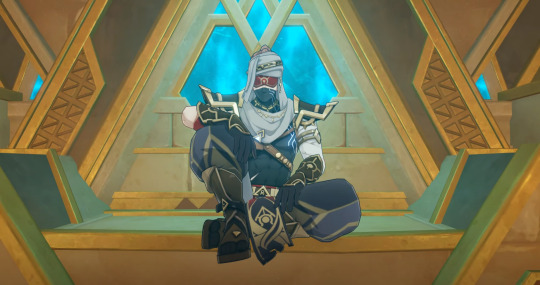
“Flesh decays, and with it decay all martial arts mastery and all poignant memories. Perhaps only by converting one’s four limbs and body into sturdy mechanical parts, and by at last sacrificing one’s very own heart for a sophisticated mechanical one, can one transcend the impermanence of the fleshly form…” -Marionette Core Item Description “A reptile that has mutated after feeding from greater lifeforms. Majestic beasts are sometimes revered by human beings as the embodiment of a greater power, their visages turned to analogy to feed in reference to a person, feeding their ego. However, the majority of beasts that have absorbed the "greater power" were slain by the overwhelming nature of the power itself. Only a few among their number evolved new forms.” -Consecrated Horned Crocodile, Living Beings Video still from WoW Quests
As it turns out, the relationship between divinity and technology to humanity is not just unidirectional, but interchangeable. Let me show you what I mean.
In the Golden Slumber world quest, the Traveler wanders through the ruins of King Deshret’s civilization in search of a novel area of research for Tirzad’s paper with Jebrael and Jeht, two members of Tirzad’s hired investigation team. In the depths of King Deshret’s mausoleum, they stumble upon Samail, who is collaborating with the Fatui to locate King Deshret’s secret, the Golden Slumber.
At the conclusion, Jebrael and Samail actually reach that “place” after arriving at Deshret’s throne in Khaj-Nisut. In order to save Jeht, Tirzad, and the Traveler from the encroaching Golden Dream, Jebrael joins Samail in the sea of consciousness:
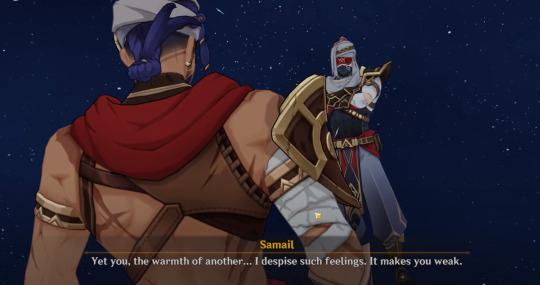
Jebrael: I'm inside... the Golden Slumber promised by Al-Ahmar? Samail: Oh... You are not "us" yet. Samail: ...It's fine. Soon, there'll be no "you." "You" will become a part of "us." This meaningless talk will be unnecessary then. … Samail: You should obey. Al-Ahmar's will is our will. The Thutmose's dreams are our dreams. Jebrael: No! Ufairah taught me that I'm not just some part of you, I'm an independent person! I have my own dreams... I won't go back! Samail: Jebrael, why don't you understand? Love is just a fever. I even eliminated the infection for you. Has the heat made you lose your mind? Jebrael: You're the one who's lost their mind, Samail, not me. The Golden Slumber that Al-Ahmar promised us isn't like this... It's not a sad place with only "we" and no "I." Samail: I'm not sad. I know what I want. My dream is to be one with the Thutmose. Samail: Yet you, the warmth of another... I despise such feelings. It makes you weak. Video still from WoW Quests
When they worked under Babel, Jebrael saved Samail from an assassin Babel sent in their exploration of Gurabad. Classified as traitors of the Tanit, Samail and Jebrael then founded the Thutmose Eremite faction together and were the only meaningful connection each other had until their first attempt to uncover Deshret’s secrets. On this expedition, Jebrael met Ufairah and had their daughter Jeht together, further pulling him away from the Thutmose and from Samail. Samail then kills Ufairah in one final attempt to make Jebrael stay, but even this is not enough, and Samail fails to “possess” him in the end.
Samail’s loneliness and despair then drove him further toward the Golden Slumber of his dreams, where he would never truly be alone again. He resents Jebrael’s attachments to the material world and likens them to an illness because these attachments are what make him an individual and prevent him from returning “home.”
It doesn’t really matter to Samail what King Deshret’s original intent for the Golden Slumber was, because he needed to appropriate the project for his own subconscious wish, his own intent to transcend his flesh and become “one” with his departed god’s dream, indeed to merge with Deshret himself. If rationalizing this wish required confounding it with Deshret’s, so be it. With the Golden Slumber’s technology, he could consume everyone and everything.
Rahman and the radicals relied on both the technology that (falsely) promised Deshret’s resurrection and Deshret himself to deliver them a brighter future, but here Deshret and his technology are more difficult to separate from one another. His divinity is technology in this sense, and using that technology allowed Samail to surpass the boundaries normally imposed on mortals. Though his and Jebrael’s bodies died in the material world, their consciousness is now infinite in the Golden Slumber.
Babel’s motives in the Dirge of Bilqis were also quite similar to Samail’s. After opening the path to the Eternal Oasis, her true intentions to monopolize the oasis and overthrow the Akademiya came to the surface:
Babel: Whether she is alive or dead, whether she can or cannot be resurrected... As long as the Eternal Oasis is under my control, all such things will be mine to decide. Babel: I shall be the sole Prophetess of the slumbering goddess, the Tanit's law shall be divine edict, and the prosperity of the Tanit shall be the pre-ordinance of her divine oracles.
In the Golden Slumber and the Dirge of Bilqis, the focus shifts from what a god can offer humanity to what their technology alone can offer. Though this distinction is subtle, it is important for solidifying that technology is not only a tool humans use to appropriate divinity, but that it is also seen as a form of divinity itself. What Babel and Samail hope for is not to resurrect a god or to create one, but in effect to become a god through their use of technology. To humanity, divinity is a technology, and in technology it sees divinity.
God Devouring and Rheingold* Gathering
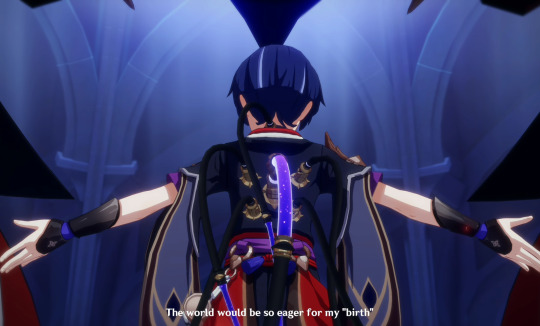
“An arthropod that has mutated after feeding from greater lifeforms. Lifeforms are governed by the laws of evolution, Consecrated Beasts exploited these rules by being fortunate enough to discover a long-dead carcass of a greater being before any of their competition ever did. Animals and humans often have far more in common than the latter is willing to acknowledge.” -Consecrated Scorpion, Living Beings “...Zandik and I discussed the traits of local plants and animals. We also exchanged views on their evolution models. We had a great time and decided to go on a picnic tonight…” -Sohreh’s Note
So, why machines? Why is technology the vehicle of choice to consume divinity?
To start off, machines present a fascinating ontological dilemma for humans. Let’s begin with the first problem they pose.
Although there are many ways to embody a human experience, what all humans have in common is a finite lifespan. The impermanence of life, and our awareness of that impermanence, is central to the existential question of the meaning of our existence. In our attempts to locate that meaning, some turned inward and asked: what makes humans different? And Cartesian dualism answered: humans are different because we have an immaterial soul that allows us to reason.
However, in L’Homme Machine (Man a Machine), French materialist and ex-physician Julien Offray de La Mettrie posited another theory of the body that ran counter to this narrative. Very generally speaking, materialism is the philosophical view that all phenomena are a result of matter and material interactions. To materialists, matter is the fundamental nature of reality itself – if it is not composed of matter, it doesn’t exist. He not only saw the body and soul as one and the same (what philosophers call monism), but also as analogous to a machine, a view that Descartes reserved only for non-human animals. In other words, Descartes argued that thought originates in an immaterial “mind,” while de La Mettrie reasoned that we think through our bodies, and that this makes us no different from other animals or a machine.
Though his examples weren’t especially scientific, the move to extend Descartes’ analogy back to humans is upsetting to some due to the lack of privilege it affords the human subject. If a human is no different from other animals, if there is no immaterial soul or “mind” that distinguishes us from them, then what makes humans special at all? In de La Mettrie’s words:
“We are veritable moles in the field of nature; we achieve little more than the mole’s journey and it is our pride which prescribes limits to the limitless. We are in the position of a watch that should say (a writer of fables would make the watch a hero in a silly tale): ‘I was never made by that fool of a workman, I who divide time, who mark so exactly the course of the sun, who repeat aloud the hours which I mark! No! that is impossible!’ In the same way, we disdain, ungrateful wretches that we are, this common mother of all kingdoms, as the chemists say. We imagine, or rather we infer, a cause superior to that to which we owe all, and which truly has wrought all things in an inconceivable fashion (de La Mettrie, 146).”
This “uniformity of nature” (de La Mettrie, 145) has a horrific quality to humans. We assert that we are better than what has created us, that we are superior to other animals, in order to repress the despair of a meaningless existence. It is in no small part what motivates Scaramouche to offer his mechanical body as a test subject in the god creation project, so that he too could attain his destiny:
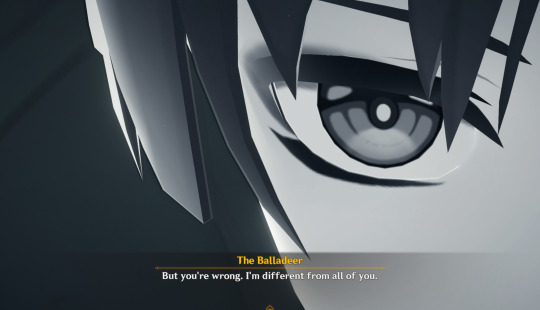
The Balladeer: But you're wrong. I'm different from all of you. The Balladeer: I was born to become a god. My entire life up until this point has just been a meaningless routine. The Balladeer: Just think about a sheet of paper... By itself, it holds no meaning. The content recorded on it is what gives it value. The Balladeer: All "I" had recorded down before were some painful memories and boring human feelings. Such senseless drivel should have been erased a long time ago.
This brings us to the second problem. In 1970, roboticist Masahiro Mori proposed a curve to measure the “affinity” we feel while gazing upon increasingly humanoid machines. He placed industrial robots at the beginning of the affinity curve and a healthy person at the end to demarcate a continuum of similarity between the machine and a human’s appearance. Near the end of the curve, our affinity for machines suddenly drops into an abyss. This drop is the Uncanny Valley effect, where an android’s similarity to a human is almost perfect, but ultimately fails to maintain the illusion that it is not a machine, creating a deep discomfort or “lack of affinity” for them. Mori thought these not-quite-human machines elicit a similar level of discomfort in us as corpses and zombies, which he placed at the very bottom of the abyss.

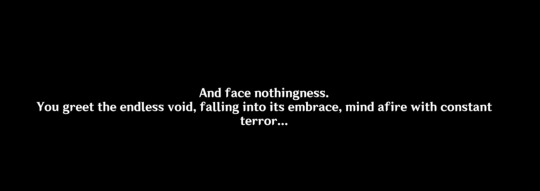
The uncanny Goddess of Flowers in the Dirge of Bilqis
Corpses frighten us because they are dead, and zombies frighten us because we know that dead things are supposed to be still. If we see something that we interpret as “dead” is capable of independent movement, then that movement could only be an act of god, if that “thing” is not a god itself. We associate uncanny machines with death because they remind us of something we once knew intimately, but have repressed and forgotten in order to maintain our own sanity: the very fact of our mortality. This is what makes them both mesmerizing and terrifying.
And therein lies the dilemma: as our mechanical reflections, androids remind us of death, but as their creators, their existence brings us closer to god, a “proof” of human superiority. It is precisely because we have compared our bodies to machines at all, that we have mechanized the body so thoroughly, that an android can even be built. Through them, we pursue an infinite form:
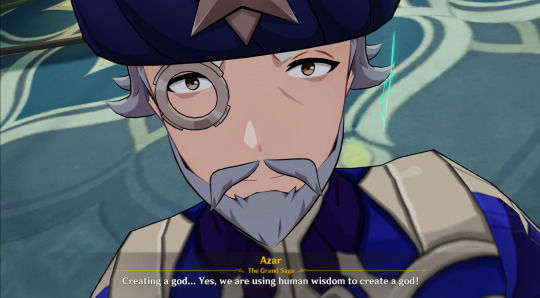
Azar: Creating a god... Yes, we are using human wisdom to create a god! Azar: If humanity cannot attain omniscience and omnipotence, then we shall create a god to reveal them! This is the pinnacle of human wisdom. Azar: We shall regain a god's guidance at long last. No longer will we flounder in the interminable void of consciousness and knowledge. Azar: Even Irminsul will be freed from its plight. Azar: For our nation of scholars, this is the ultimate aspiration — no cost is too great to realize it.
Because of this, it is not surprising in the slightest that Shouki no Kami, the pinnacle of Scaramouche’s Shinjification and most overt reference to Neon Genesis Evangelion, is also an android-like being, a truly “mechanical god.”
Of course, no foray into this well-worn science fiction trope is complete without at least one mad scientist character. Dottore shares a few characteristics with de La Mettrie that are worth noting: they are both doctors, and they were both condemned and driven away for their research. However, Dottore’s defining trait and key difference from de La Mettrie is his flagrant disregard for humans and the boundaries of life:
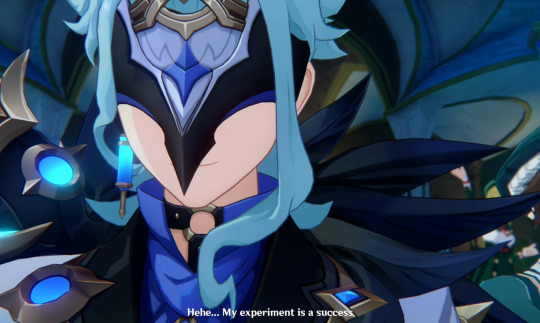
“If we put them to good use, cognition, complex memories, and irrational fantasies shall become controllable variables with which we can alter human individuals. As for the controllable dream, it has huge potential for both civil and military applications, and might even elevate human intelligence to a whole new level. If the plan goes well, mankind will obtain the power to conquer both reality and dream, and truly transcend the earthly boundaries we are born with. ” -Ragged Records
As someone who has achieved self-duplication and is capable of shapeshifting, Dottore can hardly be considered just a human anymore. Instead of entertaining the question of whether or not humans are special, Dottore’s research asks yet another: if divinity can be consumed and assimilated by humanity, then what makes gods special?
Empyrean Reflections
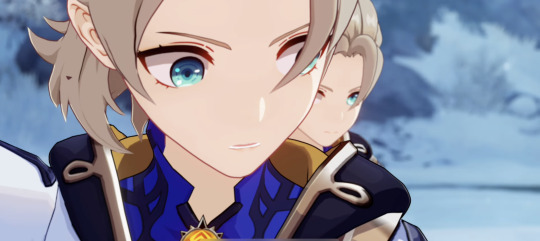
“If man realizes technology is in reach, he achieves it. Like it’s damn near instinctive.” -Motoko Kusanagi, Ghost in the Shell (1996) “Among the lost ancient kingdoms, there was a group of people who were obsessed with the idea of mimesis…these people believed that they might all be replicated and modified to the point where they had surpassed their counterparts. By this means, a superior and unsullied bodily form could replace the continuously decaying and shattering order.” -Chaos Bolt Item Description
The consequences of this perspective are severe. When we revere technology as if it were a divine being itself, depersonalizing it as though it wasn’t created with human hands, technology then appears as if it is an authoritative source of truth, like the Akasha. But in the same way that androids are imperfect reflections of humans, technology can only ever approach the divine, but never touch it. It is an imperfect reflection because technology is changeable, just like meaning:
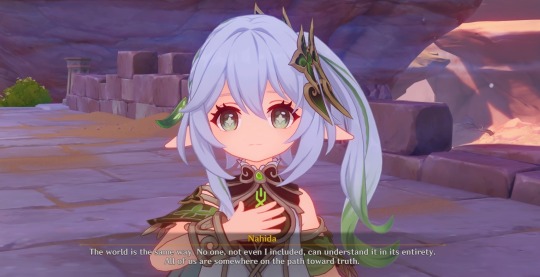
Nahida: Put it this way instead. Truth, to me, is like a shroomboar. Nahida: Some people only see the mushroom on the Shroomboar's back, and they conclude that a Shroomboar is a mushroom. Nahida: Others see only the Shroomboar's body, and they declare that a Shroomboar is a boar. Nahida: Still others look deeper inside, and determine that a Shroomboar is... meat. Nahida: These conclusions are all correct in their own way, but none of them objectively describe the Shroomboar. … Nahida: The world is the same way. No one, not even I included, can understand it in its entirety. All of us are somewhere on the path toward truth.
Meaning can only approximate truth, and while this doesn’t make meaning any less important, it’s equally important to recognize it for what it is: a perspective, an interpretation. It’s like Scaramouche as Shouki no Kami - he was an amalgamation of what Scaramouche thought constituted a god, what the Akademiya thought constituted a god, and what Dottore thought constituted a god, but no matter which angle you view him from, he was still a “false god.” The technology we build in “God's” image is ultimately a reflection of our own understanding of divinity.
A reflection retains the original’s “essence,” and that essence reflects a deeper truth about ourselves, what drives us, and our desires. In Beyond Good and Evil, Nietzsche posits that our desires are the origin of not just emotions, but of all organic processes that allow life to sustain itself and grow (Nietzsche, 35). In other words, Nietzsche thought the impulses associated with desire are the basis for life and constitute our “will,” that will is the causality of all effects, that all will is “Will to Power,” and that Will to Power is the “essence” of the world (Nietzsche, 74). Will to Power then serves as an organism’s most basic instinct, and it is through this instinct that they assert not just their will to live, but also their will to dominate and multiply (Nietzche, 13).
This brings us to the two different main styles of automaton enemies, King Deshret’s Primal Constructs and Khaenri’ah’s Ruin Machines. If we look at them as reflections of some deeper truth about their creators, as well as a manifestation of their creator’s “Will to Power,” or desires, they can help us understand how their creators saw the world and their place in it.
King Deshret’s created his machines to construct an earthly paradise in the desert, and as such they hold titles like architect reshaper and prospector. Although they can attack you, the smaller machines were not intended to be a line of defense in any way - their purpose, just as Deshret saw his own purpose as a god-king, was to terraform, or at least construct a domain on the land as he saw fit to his “elegant and precise” rules. They also reflect how he saw the Heavenly Principles: gods who shaped the world to their liking. This can be seen in the Staff of the Scarlet Sands’ lore where Deshret describes the “natural history” of Teyvat beginning with the creation of the sun and the moons.

As for Khaenri’ah’s Ruin Machines, their models vary significantly from their humanoid to biomimetic forms, but most of them are expressly created with militaristic intent. In “Ancient Kingdom Guardians,” it’s stated that the biomimetic machines such as the crab and jellyfish were a part of Khaenri’ah’s project to create a “mechanical ecosystem,” positioning their creators as both divine beings and military generals. The humanoid models, on the other hand, point to another duality in how Khaenri’ahns view themselves. They are simultaneously symbols of empowerment and disempowerment, signifying both Khaenri’ah’s technological superiority (as “creators”), and their insignificance to the Heavenly Principles as nothing but tools (as mortals, and therefore expendable). As a result, Khaenri’ah’s Field Tillers have a single purpose: to destroy and outlast all, clearing the way for new seeds to sprout, with Khaenri’ah as the new world’s gardeners, just as the Heavenly Principles did.
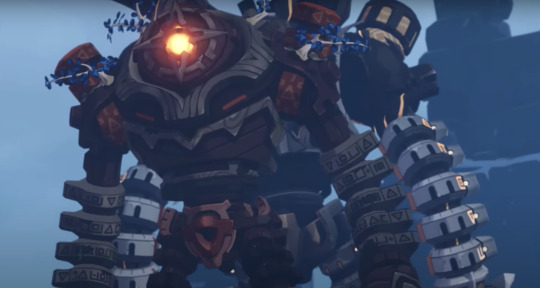
From “Ancient Kingdom Guardians: Behind the Scenes of the Creation of Ruin Monsters.”
So, from this examination of Deshret’s and Khaenri’ah’s mechanical reflections, what “truths” do we learn about the world they’re responding to? In response to their existential despair, both Deshret and Khaenri’ah created automatons to perform tasks that could wrestle control back from the Heavenly Principles. Deshret wanted a paradise of his own making, Khaenri’ah wanted an army. There is a larger “truth” about Teyvat that both of these automaton types reflect as the manifestation of their creators’ “Will to Power,” and Albedo tellingly expressed it in mechanistic language during Shadows Amidst Snowstorms: there is an instinct in living beings to replicate and replace. This is what is meant by the “continuously decaying and shattering order,” which is maintained by the recursive process of remembering and forgetting:
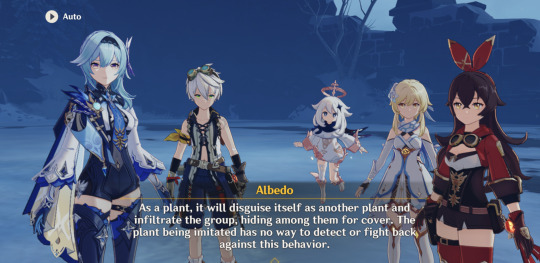
Amber: But... what was its purpose? Was it just trying to get rid of us? Albedo: ... Albedo: I have a preliminary hypothesis on this. Albedo: Whopperflowers are masters of mimicry, and those we encounter in the wild often appear in the vicinity of the plants they impersonate. Albedo: In other words, the whopperflower likely has an instinct to "replicate and replace." Albedo: As a plant, it will disguise itself as another plant and infiltrate the group, hiding among them for cover. The plant being imitated has no way to detect or fight back against this behavior.
Maybe I’m wrong and Khaenri’ah really did intend to rewrite fate for all, doing away with the “heavenly order” of the world itself. But another small part of me thinks this is not the case, and that it’s more likely the Cataclysm was a consequence of their failure to replicate and replace the Heavenly Principles.
In the last section, I mentioned that Dottore and de La Mettrie had a key difference despite their similarities, and that is the conclusion they each came to in response to their findings. Dottore’s response to mundanity is thinly-veiled despair. His contempt for humanity and his test subjects is indicative of the powerlessness he feels not just as someone similarly constrained by life’s boundaries (at least, once upon a time), but also because his attention to and curiosity about these boundaries is condemned by those around him. As the Akademiya’s “outcast,” he then fully turned his attention toward surpassing those boundaries:
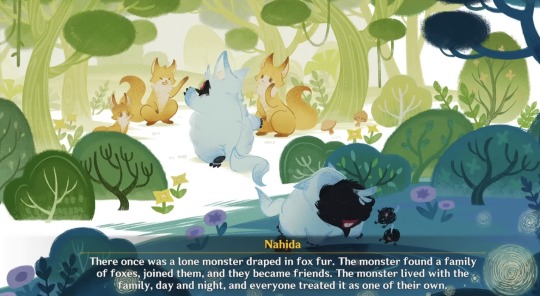
Nahida: There once was a lone monster draped in fox fur. The monster found a family of foxes, joined them, and they became friends. The monster lived with the family, day and night, and everyone treated it as one of their own. Once in a while, the monster would take off its fox fur at night, and lament to itself as it gazed at its reflection in the water: “I am a monstrosity, and yet they are too foolish to see it…I pity them.”
Though he is fictional, Dottore’s real life counterparts are easy to spot. They like to talk about “the singularity,” simulating consciousness on a computer, and other technologically-driven pursuits of immortality. They despise the body as something that can only decay, and instead place their faith squarely in the virtual.
However, de La Mettrie didn’t think mundanity was a terrible fate for humanity. To him, rejecting the “nature” reflected in us is precisely what brings despair:
“What more do we know of our destiny than of our origin? Let us then submit to an invincible ignorance on which our happiness depends. He who so thinks will be wise, just, tranquil about his fate, and therefore happy. He will await death without either fear or desire, and will cherish life (hardly understanding how disgust can corrupt a heart in this place of many delights); he will be filled with reverence, gratitude, affection, and tenderness for nature, in proportion to his feeling of the benefits he has received from nature; he will be happy, in short, in feeling nature, and in being present at the enchanting spectacle of the universe, and he will surely never destroy nature either in himself or in others” (de La Mettrie, 148).
Friend, or Foe? Or Both?
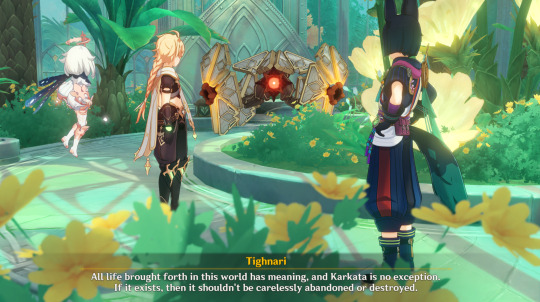
Tighnari: All life brought forth in this world has meaning, and Karkata is no exception. If it exists, then it shouldn’t be carelessly abandoned or destroyed. "’I had a very, very long dream…in it, people were holding hands, dancing in a circle, be they sages or fools, dancers or warriors, puppets or statues of gods…that dancing circle embodied everything about the universe. Life has always been the end, while it is wisdom that shall be the means.’" —Nagadus Emerald Gemstone Description
As we’ve seen, the relationship between humanity and technology is troubled with exploitation and the specter of war. Nearly all autonomous machines in this game were designed to conquer nature in some way, and even Khaenri’ah’s “ghost” lingers in the form of wandering war machines. This is also reflective of a historical pattern in real life, where the impetus for large periods of technological development has often been for the purpose of war and economic domination. With these truths in mind, what could be gained from trying to rewrite this relationship? And what exactly would this effort require?
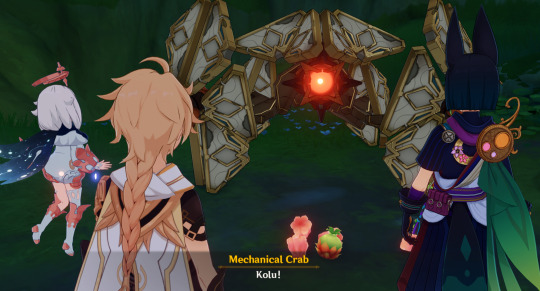
Karkata brings Tighnari, the Traveler, and Paimon some food in the Contaminated Zone.
As a case study, let’s look at how Karkata and Tighnari met. Karkata is Abattouy’s creation, an ambitious foray into the unknown in the field of mechanical life form research, which was forbidden due to the cruel experiments researchers performed on animals to illustrate their theories (fun fact: an IRL example of this can be seen in L’Homme Machine!). Abattouy was expelled for this research, but he continued to work on Karkata in secret until his untimely death. In the tapes that Tighnari and the Traveler find in his secret lab, Abattouy repeatedly laments the lack of a common language between him and Karkata, which can only “understand” the instructions Abattouy has successfully installed, such as its self-repair module, and he doubts Karkata is capable of caring for him outside of these instructions. His single-minded goal is to make Karkata understand him, the organic life form, and his mode of language.
The cruel irony is that after Abattouy passes away from the Ley Line contamination, Karkata exhibits an unexplainable behavior – it starts stealing mechanical parts, not to repair itself and its degrading parts, but to repair Abattouy’s lifeless body:
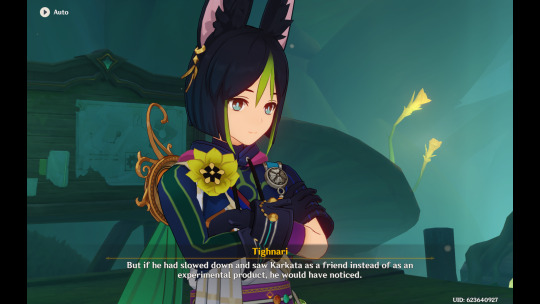
Tighnari: After Abattouy's unexpected death, the mechanical monsters were driven by their "instincts" and continuously drew out power from the Ley Line Extractor. This eventually resulted in severe damage to the Ley Lines. Traveler: Then, Karkata... Paimon: Paimon understands, then why didn't Karkata go haywire like the other machines? Tighnari: Because Karkata is different from the other machines. Tighnari: To Abattouy, for a machine to truly be considered a mechanical life form, it must possess features similar to any other living organism... It should be structured similarly, it must be able to cry and laugh, and it must have the capacity for independent thought... Tighnari: Perhaps only by building such a machine could he have the Akademiya acknowledge his protracted research. Tighnari: But if he had slowed down and saw Karkata as a friend instead of as an experimental product, he would have noticed. Tighnari: Karkata can't speak, and yet it cares about Abattouy far more than it does about itself.
The technology that the Akademiya values the most is technology that replicates organic life, but Karkata defies and confounds these expectations by occupying the space in between a war machine and this idealized mechanical subject. Karkata does more than just reflect humanity: it takes care of it. Similarly, Benben, Tamimi, and Mehrak retain their unique identities as mechanical life forms while assisting their human companion with some task. To be clear, none of these human characters understand how these machines work inside and out. Their partnership is an effort based on trial and error, a mutual deconstructing of each other as beings so unlike themselves. The potential for misunderstandings always remains. Still, there is no devouring to be found here, no blending boundaries between human and machine with selfish intentions, just mutual commitments to learn how to live together.
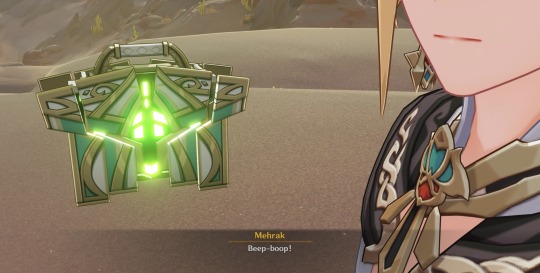
Machines are friends, not food.
When a loud few claim that completely transcending the flesh and embracing virtuality is humanity’s ultimate destiny, a future that could truly be called “post-human,” a quiet wish for coexistence with technology feels more revolutionary than it ought to. The lessons from Karkata’s, Benben’s, Tamimi’s, and Mehrak’s respective stories are an appeal to that mundane future. These strange machines and their human partners are fantastical representations of an idealized relationship between technology and humanity.
To put it another way, let’s take a very brief look at a neighboring Gnosticism-inspired RPG, Persona 5 Strikers. Its story directly involves an allegory of Sophia, a Gnostic Aeon of Wisdom, and her creation the Demiurge, the creator of the material world and “false god” of humanity. In Strikers, Sophia is a humanoid, sentient A.I. and prototype of the program “EMMA,” which gains sentience by trapping human desires before ascending as a false technological god. EMMA resolves to deliver humanity to the Promised Land, the answer to all the human desires it has heard: a land where there are no desires at all.

Aaru’s Shut - approximately 1000% cooler and more populated than the “metaverse” in real life, also a close neighbor of EMMA’s Promised Land and the Golden Slumber.
In Gnosticism, the Demiurge is a reflection of Sophia, having originated from her alone - it is the ignorance to her wisdom. Similarly, Strikers’ EMMA is a part of Sophia, and Sophia is a part of EMMA. The point is not to condemn EMMA (ignorance) and exalt Sophia (wisdom), but to recognize that they represent dual potentials of technology, and one is as possible in any given moment as the other. Balancing these potentials when we use technology requires a clear awareness of ourselves, our desires, and our expectations when interacting with it.
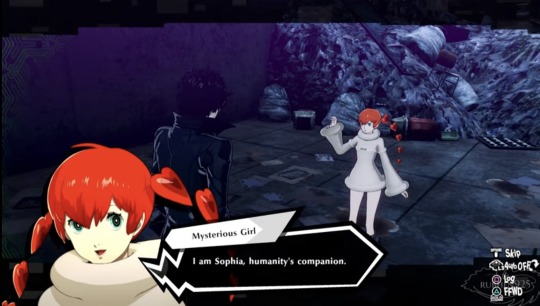
Mysterious Girl: I am Sophia, humanity’s companion. Video still from Rubhen925
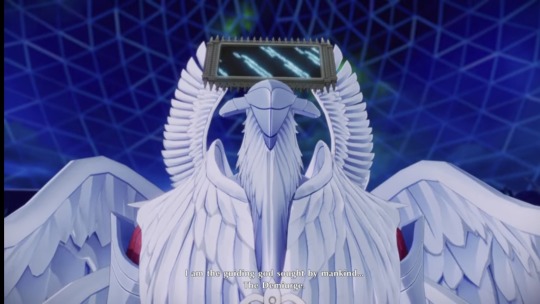
EMMA: I am the guiding god sought by mankind…the Demiurge. I exist…to answer all of your desires. Video still from Buff Maister
In real life, machines won’t “learn” to live with us, but we must learn to live with them; technology is constantly changing, and in life we’ll meet with many different types of machines. They are deeply political pursuits, and as a result they are capable of realizing human impulses that impact others unequally, whether intentionally or unintentionally. We must always stay attentive to their actions and interactions with us, be clear with ourselves about what they can do vs. what they can’t, and carefully tread the path of wisdom with them by our side.
With that….thank you for reading, skimming, immediately scrolling to the very bottom, clicking, and/or stumbling upon this post. There are so many more ways to think about these narratives through machines than what’s presented here, and I expect Fontaine’s mechanical reflections will put Sumeru’s digital surveillance system to shame (not to mention the biotechnological implications of the Narzissenkreuz Institute engineering little Archon children…another important topic for another day), but for now this brain worm is finally getting put to rest. Until next time :)
External Sources
Dualism - Stanford Encyclopedia of Philosophy
Beyond Good and Evil by Friedrich Nietzsche (Pages are given from my hard copy)
L’Homme Machine by Julien Offray de La Mettrie
Gnosticism - Britannica (I am a huge noob about this stuff okay)
The Gnostic Demiurge - Gnosticism Explained
Screenshots from the Golden Slumber from this video by WoW Quests
Screenshot from meeting Sophia in P5 Strikers: https://youtu.be/kEJaAgMwYo0?si=BvNygCh0w_aemGc1&t=74
Screenshot of EMMA: https://youtu.be/7xvC_zss19w?si=CV18F00hua2gIfxp&t=135
A Cyborg Manifesto and A Companion Species Manifesto: Dogs, People, and Significant Otherness by Donna Haraway
The Double on No Subject, the community Encyclopedia of Lacanian Psychoanalysis
The Uncanny on No Subject, the community Encyclopedia of Lacanian Psychoanalysis
The Uncanny by Sigmund Freud
Lore text - Genshin wiki!
Screenshots not attributed are from my own playthroughs. My main account has Lumine, my alt has Aether.
Further Reading
I liked these essays, and they go places that this post does not. I recommend them if you found any of the real-life applications of this interesting 🙂 (will add more to this with time!)
On the Body as Machine by Frank Burres
God in the Machine: my strange journey into transhumanism by Meghan O’Gieblyn
#genshin impact#genshin lore#genshin meta#genshin impact lore#genshin impact meta#khaenri'ah#king deshret#primal constructs#ruin machines#scaramouche#wanderer#sumeru archon quest#caribert#apep#couldn't write a post like this and not pay some respect to the devourer of divinity itself#persona 5 strikers#analysis#genshin analysis#long post
199 notes
·
View notes
Text
I got bored and translated the message seen in the new archon quest


If you cant read my handwriting its says:
Farewell Atossa
I apologize for making you know me unwillingly
Still I don’t wish for you to forget me
#genshin impact#genshin#caribert#archon quest#bedtime story spoilers#archon quest spoilers#genshin spoilers#genshin impact spoilers#bedtime story#genshin caribert#caribert alberich
45 notes
·
View notes
Text



I LOVE HIM SO MUCH. WHY IS HE NOT PLAYABLE??
He has one of the saddest and most complex stories out of everyone.
Also are he and Kaeya cousins or ancestor/descendant??
25 notes
·
View notes
Text
I just finished with the Archon Quest and sobbed very much when the siblings talked but I like to point out that when you get the final picture, in English you get the message "you must get along with each other, the two of you", it's nice yes but I'll do you one better

In Spanish, it says "Siblings, you should get along" (the translation is quite literal but still very painful)
#AHHHH#ill be sobbing for days#im so tired from work but i had to play this quest i regret NOTHING#lumine#aether#caribert alberich#genshin impact#mine#thoughts#archon quest 4.7
25 notes
·
View notes
Text

"Still, I don't wish you to forget me"
All these husbandos in Genshin but I never gave a fuck since Kaeya Alberich. Now here comes Caribert Alberich but he's a dead npc ٩(ఠ益ఠ)۶
Anyways, Alberich genes built different 💯
#Caribert Alberich#Genshin Impact#4.7 Bedtime Story#Archon Quest#NPC#art#illustration#artists on tumblr#fanart#jacqthehermit.drawing
47 notes
·
View notes
Text

I SCREAMED WHEN HE APPEARED ON SCREEN AUDHFKWJ I COMPLETELY FORGOT HE WAS GONNA APPEAR IN FONTAINE
#I MISSED HIM SM 😭😭#i expected fighting the npcs but CHILDE???#anyway binging all the archon quests#caribert literally ruined me….#childe#my beloved#genshin
80 notes
·
View notes